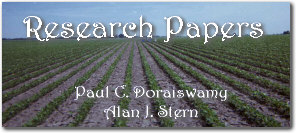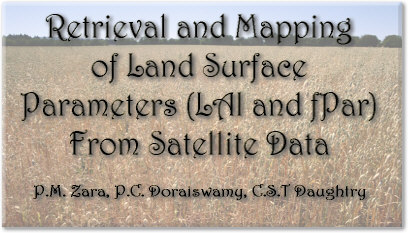| Res13 |

|
 |  | |||||||||||||||||||||||||||||||||||||||||||||||||
| ||||||||||||||||||||||||||||||||||||||||||||||||||
Pedro M. Zara Paul C. Doraiswamy and Craig S.T. Daughtry ABSTRACTAn algorithm was developed to retrieve and map Leaf Area Index (LAI) and fraction of Absorbed Photosynthetically Active Radiation (fPAR) from satellite data. The retrieval algorithm involved inversion of a physically based canopy reflectance model. Application of the procedure on a 60 x 45 Km area in southern Oklahoma consisting of a variety of cover types showed very encouraging results. The successful retrieval and mapping of LAI and fPAR depend on accurate land cover classification and good quality satellite data. INTRODUCTIONLeaf Area Index (LAI) and the fraction of absorbed photosynthetically active radiation (fPAR) are important biophysical variables required in models that simulate plant growth, hydrology and ecology. These variables describe vegetation canopy structure, and are related to functional process rates of energy and mass exchange. Both LAI and fPAR have been used extensively as satellite derived parameters for calculation of surface photosynthesis, evapotranspiration, and net primary production. Current procedures for retrieving these parameters from satellite data are based on statistical relationship with spectral vegetation indices (VI) derived from combinations of spectral reflectance measurements. Although VI's have been shown useful in estimating many vegetation parameters (Kumar and Monteith 1981, Asrar et al. 1984, Gallo et al. 1985, Sellers 1985, Nemani and Running 1989, Daughtry et al. 1992, Asrar et al 1992), other researchers have demonstrated problems with using VI for estimating fPAR (Gutman 1991, Goward and Huemmrich 1992, Asrar et al, 1992, Roujean and Breon 1995). The magnitudes of VI are strongly affected by the canopy architecture, and its optical properties, background spectral reflectance and sun/sensor geometry. The background spectral properties produced the largest effect (Goward and Huemmrich 1992), resulting in large uncertainties in the VI-fPAR relationships. Thus, the use of statistical correlation between VI and fPAR at regional scales is still a matter of uncertainty. This paper presents a physically-based procedure to retrieve and map LAI and fPAR with satellite data and ground surface information. APPROACHAn approach to retrieve and map LAI and fPAR was developed by coupling remote sensing data with a crop reflectance model (CR). Theoretically, crop reflectance models were developed to understand the interaction between biophysical characteristics of the canopy, the geometry of radiometric interaction and the resulting alteration to the reflected radiation (Goel, 1988). Hence, remotely sensed alteration in the radiative properties can be used to study characteristics of the canopy. By reversing the process (model inversion), i.e., given the canopy reflectance, surface properties may be calculated. Due to the large number of unknown variables, not all models lend themselves easily to mathematical inversion. The SAIL model (Verhoef, 1984) was used to develop the retrieval algorithm. Its performance in predicting canopy reflectance has been reported satisfactory. The SAIL model requires information on: LAI, average leaf inclination angle (ALA), single leaf reflectance and transmittance, soil reflectance, solar zenith and azimuth angles; proportions of direct and diffuse solar radiation; sensor-target geometry and date and time of satellite overpass. In this study, an iterative approach was used to solve for LAI given the reflectance as compared to mathematically inverting the CR model. The CR model generated reflectance at wavelength band of the satellite. Reflectance in two wavebands, red and near infrared, corresponding to the satellite bands were simulated and the normalized difference vegetation index (NDVI) calculated. The generated NDVI is then compared with the satellite derived NDVI. If the generated NDVI doesn't agree with the satellite derived NDVI, the CR model is rerun with a new value of LAI until an acceptable agreement with the observed reflectance is reached. The procedure assumes that all model parameters except LAI are known or can be estimated. The algorithm can be used to retrieve LAI of different canopies. Lookup tables listing canopy architectural and optical properties and soil optical properties are included in the algorithm. Additional canopy cover and soil/background information may be added to the tables. Using geographical information system (GIS), the algorithm may be used for regional assessment of LAI and fPAR. An accurate digital land cover classification and soil background information are needed input to the model. These spatially distributed information may be generated using GIS. The resulting model output can be imported back to GIS for mapping and further spatial analysis. Each land cover type is assigned each own crop and soil parameters in the lookup tables. MODEL TESTINGThe site of the Southern Great Plains 1997 (SGP97) field experiment (Jackson,1997) was selected to test and validate the parameter retrieval algorithm. The procedure to retrieve LAI and fPAR was applied to a 60X45 Km area located in the southern part of the SGP97 site. The study area included the Little Washita Watershed. Data acquired from this experiment included LAI, fPAR and above ground biomass from 150 sample points from the watershed and surrounding area. Ancillary data sets included digital soils data from STATSGO, land cover classification map, and Landsat TM Satellite data. The land cover map developed in an accompanying study was used to identify land cover types in the study area. The land cover map was developed from several multi-spectral and multi-temporal Landsat TM imagery using a supervised classification technique (Figure 1). Eleven land cover types evolved from the classification. Grasslands (Forage and Pasture) were the dominant cover type, about 60%, winter wheat (15%) and tress (10%), alfalfa (5%) and summer crops (corn and legumes, 3%). Landsat TM images acquired on four dates (April 20, June 7, July 7 and July 25, 1997) were available for developing the land cover map and parameter retrieval algorithms. The TM images were georeferenced on the same coordinate system and corrected for atmospheric effects using the algorithm developed by Liang et al., 1997. The July 7 image coincided with the experimental period (June 18- July 18) and was used to demonstrate the parameter retrieval algorithm. Simulations were carried out only for the herbaceous cover types. RESULTS AND DISCUSSIONReflectance data derived from Landsat TM imagery for the various land cover types showed very high variability. The canopy reflectance ranged between 1 to 29 percent in the visible band and about 8 to 60 percent in the near IR. In general, the model underestimated the TM- based reflectance. Nevertheless, there was a good correlation between simulated and TM derived reflectance in the visible with r2 of 0.88, but not significant in the near IR band. The discrepancies between simulated and TM derive reflectances can be attributed to a number of factors, such as errors in the land cover classification, cloud contamination of the satellite data and estimates of leaf optical and canopy architectural properties. The algorithm used NDVI as the parameter for comparing simulated versus satellite observed reflectance. The disadvantage in using of NDVI is that potentially numerous combinations of red and NIR values would produce the same results. Table 1 presents an area-weighted mean of simulated LAI and standard deviations of the different land cover classes for July 9. The magnitude of simulated LAI variability within certain crop cover was large. This is expected because of differences in crop growth development stages and differences in the management practices such as grazing rotations, dates of cutting and probably differences in soil conditions. One may suspect the mean LAI for corn (2.1) to be too low for this time of the year. This is so because a lot of corn in the area is used for silage and is planted later compared to corn for grain which was in the tasseling stage of development in early July. Field surveys conducted in late June, confirms these observations. Overall, the simulated LAI appears to be within the range of LAI expected for each cover type in the region. A map of simulated LAI is shown in figure 2. The zero LAI class included trees and urban areas where no simulations were made. Cover types that has less than 20 contiguous pixels were not used in LAI simulations. Pasture had the highest mean fPAR while legume had the lowest. A map of fPAR is shown in figure 3. Simulated fPAR ranged from 0 for senescent winter wheat to greater than 90% for the fully grown or mature cover types. The final map product was developed by running a five square pixel filter through the entire image to create an areal average of the parameter.
CONCLUSIONAn algorithm to retrieve LAI and fPAR from satellite data was developed to describe the vegetation distribution in a 60 x 45 Km area in the southern great plains of Oklahoma. The algorithm was able to retrieve LAI's of the different herbaceous land cover types. The successful retrieval of parameters depends on good quality satellite data and accuracy of the land cover classification. The results of the simulations were very encouraging and appeared to be within the range of expected LAI for the region. Further refinement of the procedure such as using a single band and validation with ground truth data are still in progress. ACKNOWLEDGMENTSThe authors would like to acknowledge Alan Stern for providing assistance in image processing and the development of parameter map products. Landsat TM data was provided by USDA, Foreign Agricultural Service. This research was funded by USDA-ARS and NASA-MTPE projects. REFERENCESAsrar, G., Fuchs, M., Kanemasu, E.T. and Hatfield, J.L. (1984). Estimating absorbed photosynthetic radiation and leaf area index from spectral reflectance in wheat. Agronomy Journal, 76:300-306. Asrar, G., Myneni, R.B., and Choudhury, B.J. (1992). Spatial heterogeneity in vegetation canopies and remote sensing of Absorbed Photosynthetically Active Radiation: a modeling study. Remote Sensing of Environment. 41: 85-101. Daughtry, C.S.T., Gallo, K.P., Goward, S.N., Prince, S.D., and Kustas, W.P. (1992). Spectral estimates of absorbed radiation and phytomass production in corn and soybean canopies. Remote Sensing of Environment. 39: 141-152. Goel, N.S. (1988). Models of canopy reflectance and their use in estimation of biophysical parameters from reflectance data. Remote Sensing Reviews. 4: 1-212. Goward, S.N. and Huemmrich, K.F. (1992). Vegetation canopy PAR absorptance and normalized vegetation index: an assessment using the SAIL model. Remote Sensing of Environment. 39: 119-140. Gallo, K.P., Daughtry, C.S.T., and Bauer, M.E. (1985). Spectral estimation of absorbed photosynthetically active radiation in corn canopies. Remote Sensing of Environment. 17: 221-232. Hatfield, J.L., Asrar, G., and Kanemasu, E.T. (1984). Intercepted photosynthetically active radiation estimated by spectral reflectance. Remote Sensing of Environment. 14: 65-75. Kumar, M., and Monteith, J.L. (1981). Remote sensing of crop growth. In: H.Smith (Ed.), Plants and the Daylight Spectrum. Academic Press, London. pp. 133-134. Liang, S., Fallah-Adll, H., Kalluri, S., Jaja, J., Kaufman, Y.J., and Townsend, J.R.J. (1997). An operational atmospheric correction algorithm for Landsat Thematic Mapper imagery over land. J. of Geophysical Research. 102:17175-17186. Roujean, J., and Breon, F. (1995). Estimating PAR absorbed by vegetation from bidirectional reflectance measurements. Remote Sensing of Environment. 51: 375-384. Sellers, P.J. (1985). Canopy reflectance, photosynthesis and transpiration. International Journal of Remote Sensing. 6, 1335-1372. Verhoef, V. (1984). Light scattering by leaf layers with application to canopy reflectance modeling: The SAIL model. Remote Sen. Environment. 16: 125-145 FIGURES | ||||||||||||||||||||||||||||||||||||||||||||||||||





